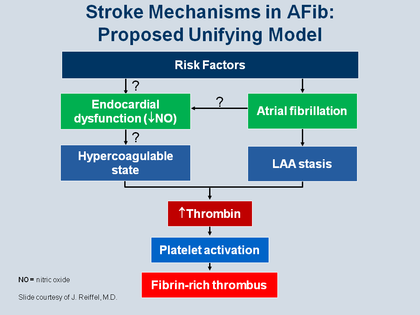Reiffel - Atrial Fibrillation and Stroke: Epidemiology - Figure 12
Stroke Mechanisms in AFib
The Figure shows a proposed unifying model of the mechanisms by which AFib leads to stroke, beginning with the risk markers for AFib that relate to underlying conditions.
On the left in the Figure is endocardial dysfunction (with decreased nitric oxide availability) that may be increased by the risk factors and worsened during AFib, leading to a hypercoagulable state.
On the right, atrial fibrillation creates hemodynamic stasis, which again results in a hypercoagulable state.
Both of these factors result in increased thrombin and platelet activation, thereby leading to creating of fibrin-rich thrombus, which forms the nidus for the emboli in the fibrillating left atrium.
Reiffel JA. Am J Med 2013; 126: 00-00.

